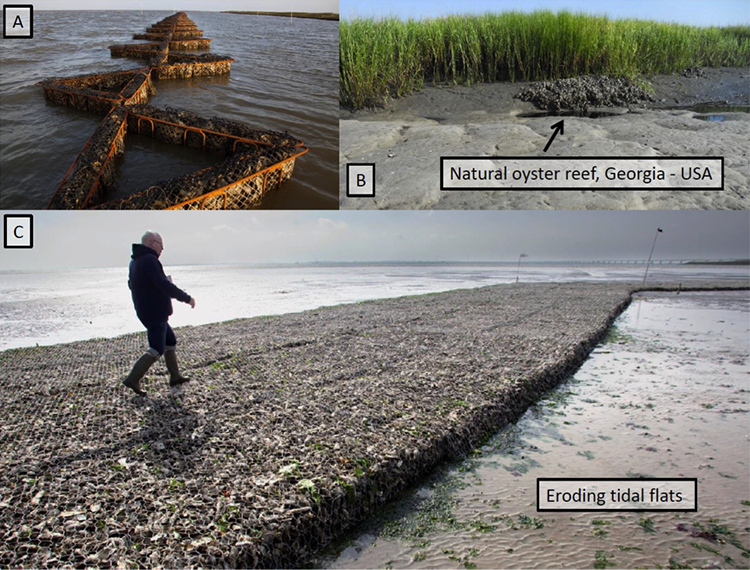Case Study 5: Protecting Tidal Flats and Marsh Edges with Artificial Oyster Reefs
“Ecosystem engineers” use ecosystems whose species’ activities are able to modify the local physical environment, for instance promoting sedimentation or assisting in the self-organization of landscapes. Ecosystem engineers have found that salt marshes, mangroves, and other habitats that can be effective agents for enhancing coastal protection.
In one of the most versatile ecosystems used by ecosystem engineers, oysters transform soft sediments into hard to form complex 3D structures (i.e., reefs) that modify the near-bed water flow and dissipate wave energy, thus influencing sediment transport dynamics and promoting sedimentation in nearby environments. Oyster reefs offer additional ecosystem services, such as water filtration, and their aggregations and biogenic structures facilitate dense assemblages of invertebrate species, as well as provide shelter and foraging grounds for juvenile fish and crustaceans. Oyster reefs are among the most diverse marine habitats.
In one instance of ecosystem engineering, oysters are used in clusters within arrangements of rebar to provide the basis of what will eventually become a reef and help reduce wave energy transmission onto the marsh edge and platform. This approach helps reduce the direct breaking wave energy arriving at the marsh edge and ultimately reduces shoreline erosion. Applications using such solutions include navigation channels and natural waterways where commercial and/or recreational traffic produces above-normal wave energy. The area between the reef and the marsh experiences increased sedimentation, which helps deliver more sediment onto the marsh platform; over time, this sediment accretes to a shallow slope that helps dissipate energy further, and potentially offsets erosion.
Another application uses gabions filled with oysters and oyster substrate to protect tidal flats. Tidal flats provide a variety of ecosystem services, but sea level rise and human-induced stresses are causing widespread erosion. To combat this erosion, experiments in the Eastern Scheldt estuary in the Netherlands (which you saw earlier in this module) use oysters to help reduce wave energy during sub-tidal conditions, trap sediment, and reduce erosion of the tidal flats. Reducing erosion sustains the landform, thereby extending the longevity of the flats and their habitat.

